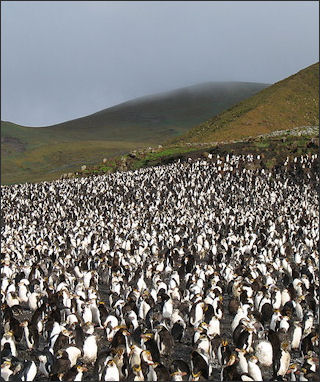PENGUINS
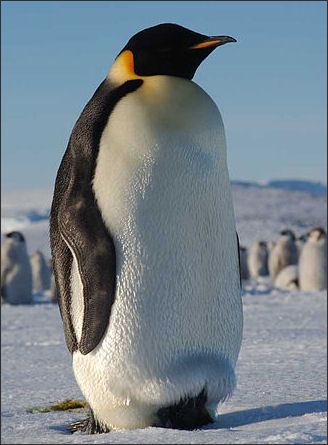
Emperor penguin
Penguins are birds. They have wings but they can not fly. The wing structures of penguins evolved for swimming, rather than flying in the traditional sense. Penguins swim underwater at speeds of up to 24 to 40 kilometers per hour (15 to 25 miles per hour) but they so in a way the resembles flying. Penguins spend a lot of time in the water. Some penguins spend up to 75 percent of their lives in the water. Like other birds, penguins lay eggs and raise their chicks on land. All penguins live in the Southern Hemisphere. [Source: NOAA]
The Scientific name for penguins is Sphenisciformes. which comprises six genera, and 17 species. Penguins are oceanic or coastal residents, breeding on coasts and glacier ice. Only three species of penguins are indigenous to the Antarctic and one, the Galapagos penguin, is found as far north as the equator. Species farther away form the Antarctic may inhabit inshore waters and breed in coastal or forest habitats.
All penguin species generally congregate around cool or cold ocean currents where they find food. Penguins dive well and use their flippers to swim underwater in pursuit of prey such as small fish like anchovies, pilchards, cuttlefish, squid, krill and fish fry. Penguins tend to live for a long time, but their juvenile mortality rate is high. Many breed in large colonies and become highly territorial in the breeding season. Galapagos Penguins have been observed foraging with boobies, terns, and shearwaters. Predators of penguins include: humans, leopard seals, killer whales and sharks. Stoats, rats and weka (giant insects) feed on their eggs. [Source: Laura Howard, Animal Diversity Web]
Twelve penguin species are included in the International Union for Conservation of Nature (IUCN) Red List of Threatened Species, three of those (Eudyptes sclateri, Megadytpes antipodes, Spheniscus mendiculus) are listed as Endangered. Major threats to wild populations include: hybridization, destruction of breeding habitat, human disturbance, egg and guano collection, predation by introduced mammals, commercial fishing, and oil spills. [Source: Laura Howard, Animal Diversity Web (ADW)
See Separate Articles: SEA BIRDS: TYPES, MIGRATIONS AND THREATS ioa.factsanddetails.com ; ENDANGERED PENGUINS: DECLINING NUMBERS, THREATS ioa.factsanddetails.com ; PENGUIN BEHAVIOR, SEXUALITY AND YOUNG ioa.factsanddetails.com ; EMPEROR PENGUINS: CHARACTERISTICS, BEHAVIOR, SWIMMING ioa.factsanddetails.com
Websites and Resources: Animal Diversity Web (ADW) animaldiversity.org; National Oceanic and Atmospheric Administration (NOAA) noaa.gov; Encyclopedia of Life eol.org; Smithsonian Oceans Portal ocean.si.edu/ocean-life-ecosystems ; MarineBio marinebio.org/oceans/creatures; Expert: P. Dee Boersma, a University of Washington conservation biologist, is regarded as the Jane Goodall of penguins. She has worked for over a quarter of a century with Magellanic penguins in Punto Tombo, Argentina. Film: “March of the Penguins” won the Academy Award for best documentary in 2005. It is about emperor penguins and was made by the French filmmaker Luc Jacquet.
Penguin History
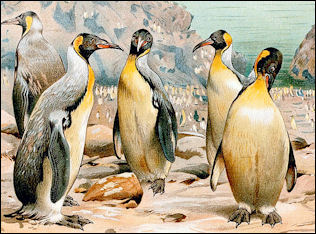
prehistoric penguin Pachydyptes ponderosus Penguin have remained virtually unchanged for the last 45 million years except for their size and a few odd features. One extinct species that lived 42 million years ago was 170 centimeters tall. Another species — the “Icadyptes salasi”, whose fossil remain were found in central Peru and lived 36 million years ago — had a javelin-like beak that was 30 centimeters long, thick neck muscles and stood 150 centimeters tall. Perhaps what was most extraordinary about this creature was that it lived in tropical waters.
At least eighteen penguin species are represented in the fossil record of the Southern Hemisphere and date back to the middle or late Eocene (47.8 million to 33.9 million years ago). A common ancestry for penguins and procellariids is suggested by the presence of tubular nostrils in fossil penguins and in the extant Little Penguin (Eudyptula minor). Scientists have deduced that prehistoric penguins had reddish-colored feathers by comparing tiny pigment packages called melanosomes from fossil plumage with those of living birds. [Source: Laura Howard, Animal Diversity Web (ADW)
According to Animal Diversity Web (ADW) Despite evidence derived from osteology, anatomy, behavior, histology, and protein comparisons, the evolutionary relationships of penguins remain elusive. Penguins have been considered related to loons (gaviids), grebes (podicepids), and/ or procellariids (tubenoses), which include pelicans (pelicanids) and frigatebirds (frigatids). DNA hybridization places penguins within Cinconiiformes (storklike bird including herons, the shoebill, storks, ibises and spoonbills) and estimates a close relationship between penguins, loons and procellariids. /=\
Historically penguins were hunted and boiled to extract oil from the heavy layer of fat beneath the skin.Whalers and mariners used to boil penguins and use the oil to waterproof their boats. In the 1800s millions of penguins were killed by hunters who boiled their carcasses in iron pots and scraped off the oil which was sold for cooking. At the turn of the century, approximately 150,000 Royal penguins harvested each year for 20 years from Macquarie Island south of New Zealand.
On islands off of the coasts of Peru and Chile, penguin eggs and guano (dry bird droppings) are still collected for local use. In the 1980s a Japanese company suggested setting up a concession in Punto Tombo and turning the hundreds of thousands of penguins into oil, protein and gloves. The plan never implemented due to the public outcry over it.
Giant Five-Foot Penguin Lived 36 Millions Years Ago
In October 2010, Reuters reported: “The preserved feathers and scales of a giant fossilized penguin discovered on Peru's central coast provide a glimpse of Peru's Eocene period, and how the species evolved to its modern state, paleontologists say. ancient version of the marine bird was about 1.5 meters (5 feet) tall and weighed almost 60 kg (132 lb), dwarfing today's Emperor Penguin, the largest of the modern-day species. [Source: Emily Schmall, Reuters, October 5, 2010]
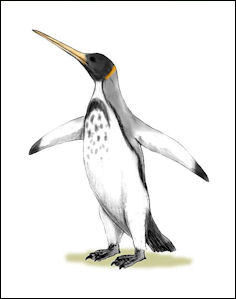
prehistoric penguin Icadyptes "By looking at this fossil, we were prompted to ask new questions about living penguins and the world we live in today," said Julia Clarke, an expert in avian anatomy at the University of Texas at Austin. The paleontologists date the remains to 36 million years ago. They dubbed the ancient penguin "Inkayacu paracasensis," which means "emperor of the water" in the indigenous language of Quechua. "Without doubt this is the most complete specimen of ancient penguins that exists," said Rodolfo Salas-Gismondi, the lead paleontologist and the head of the University of San Marcos' Museum of Natural History in Lima.
The mostly intact fossil skeleton allows scientists to understand the anatomy of early penguins, Salas-Gismondi said. The coloring of the fossil suggests penguins did not start off black and white, and may have evolved over time to adapt to new climate conditions. "The feathers we discovered are a reddish-brown. It was rather large and lived in a period when the planet was very warm, totally unlike the penguins of today. This specimen is very important for understanding the evolution of modern penguins," Salas-Gismondi said on Monday.
A young researcher first stumbled upon the remains in 2006, when he was studying the habits of aquatic birds in the Paracas National Reserve, 280 km (174 miles) south of Lima. Salas-Gismondi, who led an excavation in 2007, says the skeleton was preserved under a protective blanket of sediment, in an anaerobic environment when world temperatures were at their highest. The teeth of a prehistoric whale and shark cartilage millions of years old have previously been recovered near Paracas. "It was a truly incredible moment to see something like this for the first time," Salas-Gismondi said. The findings were first revealed in the September 30 issue of Science.
Giant Penguin Feathers
"We got incredibly excited," Clarke told AP. "Moving really slowly, flake by flake by flake through this giant block," they eventually uncovered a flipper with layers of small feathers and under it, fossilized body feathers, too. On the surface, they're shaped like the feathers of modern penguins. Popsicle-shaped wing feathers were densely stacked on top of each other to create a stiffened flipper, Clarke said. When they looked more deeply, the feathers were far different. The outer shape apparently evolved before some microscopic changes that may play a role in penguin's underwater prowess.[Source: Lauran Neergaard Associated Press, September 30, 2010]
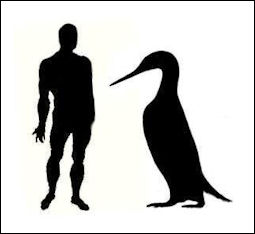 Pigment is long gone in fossils. But left behind in feathers can be microscopic packets called melanosomes that in life contained colour-producing pigments — and the shape of those melanosomes corresponds to different colours. So the researchers compared a library of melanosomes from living birds with these fossilized ones.
Pigment is long gone in fossils. But left behind in feathers can be microscopic packets called melanosomes that in life contained colour-producing pigments — and the shape of those melanosomes corresponds to different colours. So the researchers compared a library of melanosomes from living birds with these fossilized ones.
The big surprise is that it turns out modern penguins have large melanosomes packed into grape-like clusters, unlike those of any other known bird, while the extinct giant penguin's smaller melanosomes resembled those of other birds, Clarke said. The scientists can't explain the difference. But they say it probably has to do with more than the black tuxedo or dinner jacket coloration of today's penguins.
Melanin, the pigment inside melanosomes, helps feathers resist breakage. So one possibility is that the melanosomes got bigger during later penguin evolution as the birds became better underwater swimmers and needed a more hydrodynamic covering. Clarke is anxious to get back to Peru and see if more fossil finds will help tell.
Dinosaur-Era Giant Penguins
In 2017, scientists announced that a giant penguin foot-bone discovered in New Zealand showed that the ancestors of penguins lived during the age of dinosaurs. Before an asteroid wiped out dinosaurs 65.5 million years ago waddled The Earth the the same time as Triceratops and Tyrannosaurs according to a study published in the journal The Science of Nature. [Source: Marlowe Hood, AFP, February 24, 2017]

prehistoric penguin Anthropornis nordenskjoeldi According to AFP: The new find, unearthed by an amateur fossil hunter near the Waipara River in New Zealand, does not by itself prove penguin-dinosaur cohabitation. The eight-centimeter (five-inch) bone dates from about 61 million years ago, well after T-Rex and company faded from the scene. But the existence of another giant penguin fossil, found earlier nearby, is smoking-gun evidence that a shared ancestor lived millions of years earlier. "The two penguins -– from exactly the same locality — are morphologically quite different," said Gerald Mayr, an ornithologist at Senckenberg Research Institute in Frankfurt, Germany, and lead author of a study unveiling the discovery. "This suggests that their last common ancestor lived much earlier, in the time of dinosaurs."
This mother-of-all-penguins probably predated its evolutionary descendents by five to 10 million years, which would have put it squarely in the late Cretaceous period when dinosaurs still flourished, he added. Early penguins probably survived the catastrophic asteroid blast and subsequent change in climate because they their food sources were more surf than turf. By contrast, land-locked dinos that didn't burn up at impact probably starved to death during the decades-long winter that followed, scientists conjecture.
The Waipara giant penguin stood at least 150 centimeters (five feet) tall, just shy of the average height of a female human. That's at least a head taller than the Emperor penguin, the largest of the 17 penguin species — all in the southern hemisphere, and most in Antarctica — alive today. "It was probably a separate species," said Mayr. But more bones must be found before it can be declared as such, and formally named.
Only one other prehistoric penguin that lived in Antarctica between 45 and 33 million years ago, Anthropornis nordenskjoeldi, was bigger than Waipara. All the ancient, giant penguins discovered to date already moved with the upright, waddling gait characteristic of today's species, the study said.
Penguin Characteristics
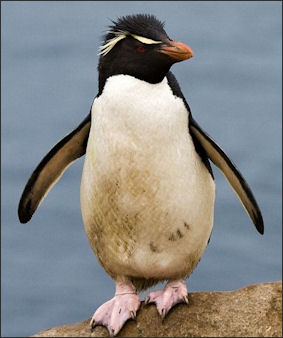
Rockhopper penguin Penguins are medium to large birds, between one and 40 kilograms (2.2 and 88 pounds) in weight and 40 centimeters to 1.15 meters (1.3 to 3.7 feet) in height (length). They are notable for their upright posture and stiff wings that cannot be folded against the body.
For protection against the cold penguins have a layer of fat, a blanket of down and an outer layer of overlapping feathers, which they anoint with secretion from a gland at the base of their tail , making them nearly impermeably to wind and water. Their outer layer is composed of thousands or small hard feathers that overlap each other like shingles Underneath these feather is a thick layer of insulated down. Underneath this penguins have several layers of body fat around their bodies.
Penguin feathers grow uniformly all over their bodies. Feathers are small and continuous and have no feather tracts. Each feather is short and stiff and has a second short shaft covered with very thin, downy filaments that together form the undercoat. On land, where it can be much colder than in the water, the feathers shift slightly away from the body so they can hold a warming layer of air. In the water, the feathers flatten out and with the help of preening oil form a waterproof skin.
Adult plumage is blue-black or gray on the back and white on the front, sometimes with distinctive coloring or plumes on the head. Chicks are either entirely brown-gray, or white on the front. Juveniles have adult-like plumage. Sexes are similar. Penguins are black on the back so the blend in with the dark sea when viewed from above and are white on the bottom so they blend in with the pale sky when viewed from below. Penguins on islands off the coast of South Africa and Namibia have spots on their chests that are as unique as fingerprints. Individuals use the markings to identity one another.
Wings are modified as flippers. Wing bones are flattened and partially fused. Penguins that live in warmer climates generally have longer appendages and more bare skin around the face to help them get rid of excess heat. Penguins that live in colder climates generally have shorter, stubbier appendages and well-insulated bodies with longer feathers to help them conserve heat. The base of wing has vascular rete (blood vessel configuration in which cooler blood returning to the body absorbs heat from blood flowing out to the wing)

Porpoising gentoos According to Animal Diversity Web: Bills are long and often laterally compressed, with holorhinal (contiguous nasal bones) and impervious nares, and schizognathous palate (with a bird-like bone arrangement). Penguins are flightless divers with poorly pneumatized (hollow or filed with air spaces) skeleton, carinate sternum with two lateral notches, 15 cervical vertebrae and basipterygoid processes absent. Pectoral muscles are large, but biceps bracii absent (unique to penguins). Legs are short; placed far posterior on body; flat tarsometatarsus is incompletely fused; palmate feet with four forward pointing toes. Bilobed oil gland is tufted. [Source: Laura Howard, Animal Diversity Web (ADW)
Penguins at Sea
Penguins use their modified wings as flippers to swim underwater and move around on the ocean surface. Some penguins spend as much as 85 percent of their life at sea. They spend days, weeks and even months at sea. For some species, the only time they come ashore is to molt and breed. Many species are migratory.
As an adaption to the sea, penguins have lost many features found in flying birds. Their bones are longer lightweight and hollow but are heavy and solid (this enables them stay underwater better); their feathers have as much in common with fur as flying feathers; they often have layers of fat (they don’t need to keep weight off to fly); and their tails have become stumps (steering is done with the feet).
Emperor penguins are exceptional divers and can stay submerged for 18 minutes and dive as deep as 500 meters (1,640 feet). When hunting emperor penguins dive below their prey so their can look up and see the fish in silhouette against the sea ice before making their move. Solid bones provide penguins with ballast when they dive. Swimming speeds average two to three knots, but may reach 15-20 knots for short distances. Swimming often includes porpoising (repeatedly breaking the water's surface with enough momentum to lift the penguin into the air for about one meter.) [Source: Laura Howard, Animal Diversity Web (ADW)
Swimming Penguins
Penguins swim with their head hunched into their shoulders and feet pressed close to their body. This streamlining minimized water resistance and allows them to get move faster and further with less energy. The penguin’s short stubby wings are adapted so penguin’s fly through the water. Like other flightless birds they still have their breastbones. Most other swimming birds swim using their feet. The only other ones that don’t are diving birds such as some species of petrel.

swimming gentoo On the surface penguins adopt a position similar to that of ducks or cormorants. Penguins swimming underwater zip around like torpedoes, leave contrails of bubbles in their wake. They can make rapid twists, turns and loops as they chase after their fast-moving fish prey and escape fast-moving predators. They use their feet and stiffened tail like rudders to steer.
Some penguins can swim faster than fish. Gentoo penguins have been observed swimming at 27mph. Most species swim between 3 and 6 mph and can reach higher speed when threatened or pursuing prey. Emperor penguins, the largest of all penguins, can stay underwater for 23 minutes and dive to 1,700 feet and sometimes travel 600 miles on a single trip.
"Underwater," the famous ornithologist Roger Tory Peterson wrote, "penguins are as clean-lined as porpoises; there heads, pulled pack to the shoulders, contribute to a torpedo-like contour... Their wings, reduced to flippers, are propelled by powerful pectoral muscles, which enable them to hit speeds of 15 miles an hour. Penguins are the only birds that have developed the trick of porpising. Time and again I have watched them leap clear of the water and then slip back in again...breathing each time they are above the surface.”
Emperor penguins surface from some of their dives with almost no oxygen in their bodies, according to research by Paul Ponganis of Scripps Institute of Oceanography, and the lowest blood-oxygen levels ever recorded in a mammal or bird. The levels are less than a quarter of the level in which most people back out. The discovery was made by inserting oxygen-sensitive probes in the penguin’s blood vessel connected to microprocessors on the penguin’s back and letting the birds go fishing. How do they do it? The answer appears to lie with special proteins in the brain called nueroglobin and cytoglobin, which appear to only need small amounts of oxygen to keep organs functioning.
Penguins on Land
Royal penguins When penguins come to shore they generally gather together with other penguins in massive colonies. Generally they come ashore to molt and breed. The annual molt generally lasts three to six weeks. During that time a penguin loses all of its feather and grows new ones. When a penguin is molting it is not waterproof and cannot enter the water. Deprived of food a penguin may lose a third of its body weight or more.
Penguins get around on land in two ways. They can prop themselves up with the stubby tails and waddle like Charlie Chaplin: or, when on ice or snow, they can lie face down and toboggan around on their stomachs, kicking with their feet and paddling with their wings. Penguins can move swiftly by "tobogganing" this way. .Some penguins hop from rock to rock.
Penguins are famous for popping out of the sea like bread from an old-fashion toaster. "Coming into land," Peterson wrote, "each penguin swam the final stretch underwater and then popped onto the shelf of rock like a jack-in-the-box...They bounced from bolder to bolder likes midgets in a sack race. When the rocks became too steep or slippery, they dug their sharp nails into grooves gouged by their ancestors over the years. Charmed by these deceptively doll-like birds, my companions were tempted to pick them up — they weigh only six pounds and stand scarcely two feet high. 'Don't try it." I warned. 'There is nothing cuddly about them. The cutting edge of a rock hopper's beak is knife sharp."
Penguins sometimes pop out of near freezing water into sunny warm weather. How do they adjust? "To avoid heat prostration when ashore" Peterson wrote, "a penguin can fluff its feathers to allow warm air trapped close to the body to escape. It may also pant, stand with its flippers well out from its body, or lie down with its feet extended, so that capillaries close to the surface of the underwing or the feat can release heat."
Scientists have long been trying to locate where penguin colonies are from space so they can make accurate assessments of their numbers and know where to look for them. But locating them from space using satellites imagery on a continent as large as Antarctica has proved to be a daunting task. One method that was discovered by accident but which seems to work is to look for penguin excrement — which appears as reddish-brown streaks on the white ice — from space.
Penguins and Leopard Seals

leopard seal Leopard seals are a penguin's greatest worry. As many as one in every three penguins may be taken these nine-foot-long predators. Peterson once came across a group of penguins who sought refuge on an ice flow, "Two of the birds were mutilated and bloody," he said. "The predatory seal, lurking under the lip of the ice, surfaced two or three times, watching us. Then an incautious penguin plunged in and swam for shore. Quick as a flash the leopard seal grabbed [the penguin] and thrashed it this way and that, literally shook the body out of the skin. A leopard seal will feed on krill, by when near a penguin colony it likes its krill pre-processed."
Penguins are known to leap into the boats of tourists when pursued by a leopard seal. On land or ice where the seal isn't so adept penguins will strut within a few feet of the predator.
Paul Nicklen witnessed leopard seals take several penguin chicks. He said what the seals prized most was a penguin stomach filled with krill and that it took them significantly more time to catch adult penguins than their young. On one attack he wrote in National Geographic, “In a death shake, the large female shred a penguin chick by whipping it from side to side...All I saw was a splash and storm petrels and gulls gathering for scraps...the large female dived to eat her prey.”
Penguins are also fed on by killer whales.
Different Species of Penguin
The smallest of the 17 species of penguin is the fairy penguin. It weighs between.7 and 2.1 kilograms and is 39 to 41 centimeters in length. The largest is the emperor penguin. It weighs between 19 and 46 kilograms and reaches lengths of 115 centimeters.
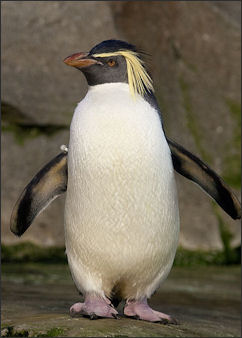
rockhopper Emperor penguins have been recorded diving to a depth of 1,720 feet and staying submerged for 20 minutes. Emperor penguins only have sex once a year for a period of two or three minutes. During copulation the female lies face down on the ice, supporting herself with her beak and flippers. The males mounts her, holding her beak with his beak, and balances himself with his flippers. The process is difficult and the male often slips and falls in the water before he is successful.
When hunting Emperor penguins dive below their prey so they can look up and see the fish in silhouette against the sea ice and then zoom in for the kill. A critter was hooked up to one in 1999 by National Geographic researchers.
The king penguin, the second largest penguin, is also the most colorful of all, with their "blue-gray jacket, bright orange collar and silvery white shirtfront.” King penguins dive to depths of 900 feet and roam 900 kilometers from their nesting areas. When they dive the pupils of their eyes widen to 300 times their size they are in the sun.
An Adélie penguin can jump 5 feet straight up. For most of the known history they fed mostly on fish then suddenly around 200 years they suddenly shifted their diet to krill. Scientists think that this happened because around 200 years ago is when seals and whales — both large consumers of krill — began being hunting extensively by humans, meaning there were less of them to eat krill. The resulting population explosion of krill meant that was more of that kind of food for penguins and other animals to eat.
The macaroni penguin, named when macaroni meant "fop," has dropping reddish gold plumes and lays two eggs, one smaller than other. Even though two chicks may hatch only one is raised. Rockhopper penguins roam 250 kilometers from their nesting areas. They poke and jostle each other and have been known to go out of their way nip at the shins of tourists.
Image Sources: Wikimedia Commons, NOAA
Text Sources: Animal Diversity Web (ADW) animaldiversity.org; National Oceanic and Atmospheric Administration (NOAA) noaa.gov; Wikipedia, National Geographic, Live Science, BBC, Smithsonian, New York Times, Washington Post, Los Angeles Times, The New Yorker, Reuters, Associated Press, Lonely Planet Guides and various books and other publications.
Last Updated May 2023

